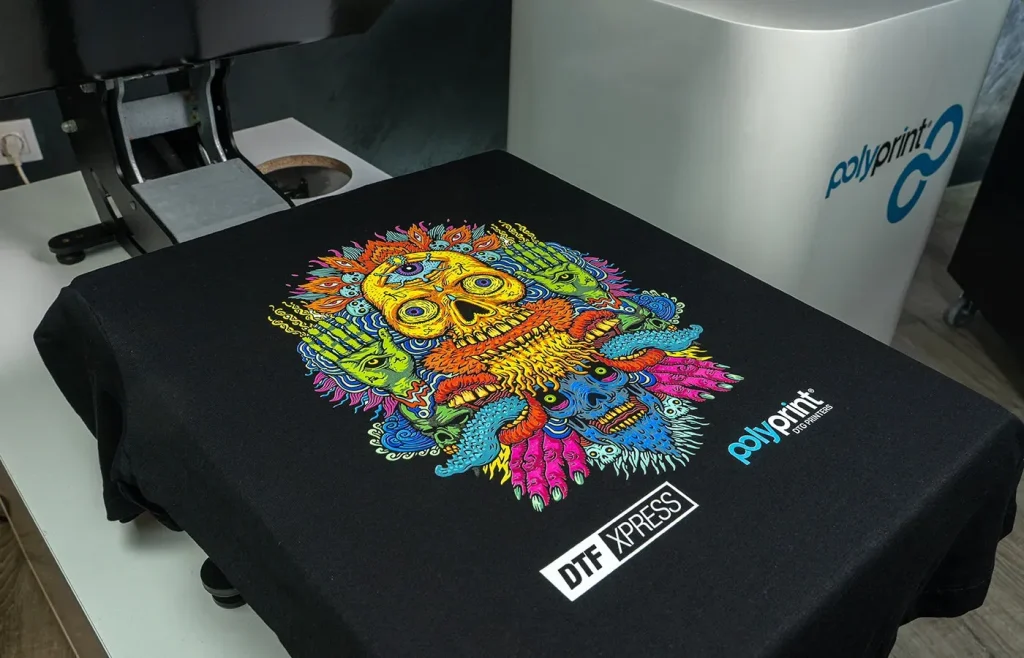DTF printing, or Direct-to-Film printing, is revolutionizing the way businesses approach high-quality graphics, offering an innovative solution for vibrant designs. This cutting-edge technique allows for stunning artistry on various materials, particularly textiles, making it the preferred choice for apparel manufacturers. Not only does DTF printing produce exceptionally sharp and colorful prints, but it also serves as a cost-effective printing solution, catering to the needs of businesses both large and small. Furthermore, with an increasing emphasis on sustainable printing practices, DTF is recognized for its reduced waste and eco-friendly attributes. As we delve into the nuances of DTF printing, it becomes clear why this method is quickly gaining traction in the competitive landscape of digital printing.
In the realm of modern printing solutions, Direct-to-Film (DTF) technology has emerged as a leader, providing an efficient alternative to traditional methods like screen and sublimation printing. This innovative approach empowers printers to transfer vibrant graphics directly onto films that can then be seamlessly applied to various surfaces, particularly fabrics. Businesses are increasingly turning to this method for its versatility and exceptional image quality, which paves the way for customized apparel and promotional items. Moreover, these digital processes not only enhance the aesthetic appeal of printed materials but also promote sustainability by minimizing waste throughout production. As industries adapt to the growing demand for high-quality and eco-friendly outputs, DTF printing stands out as a key contender shaping the future of graphic production.
What is DTF Printing?
Direct-to-Film (DTF) printing is an innovative technique that revolutionizes the way designs are transferred onto various substrates, especially textiles. This method involves printing designs onto a special film that is then heated and transferred to the target surface. The result is a vibrant, high-quality graphic that showcases intricate details and vivid colors, making it a top choice for custom apparel and other decorative fabrics.
One of the defining features of DTF printing is its ability to adhere effectively to a diverse range of materials. Unlike traditional screen printing, which often requires specific fabric types, DTF printing excels with both natural and synthetic fibers. This flexibility expands the creative possibilities for designers, enabling them to produce striking visuals on a variety of custom merchandise.
The Benefits of DTF Printing
DTF printing stands out due to several significant advantages that cater to the needs of modern consumers and businesses alike. Primarily, DTF technology offers exceptional print quality, allowing for vibrant graphics that maintain their integrity over time. This durability ensures that the printed designs withstand frequent washing and wearing, making them ideal for the fashion and promotional products market.
Moreover, DTF printing is not only about creating stunning visuals but also about efficient production. This method reduces waste significantly compared to traditional printing techniques. As many businesses strive to adopt sustainable practices, DTF printing emerges as a responsible choice that aligns with eco-friendly goals while fulfilling high-demand printing requirements.
Cost-Effectiveness of DTF Printing Solutions
In a competitive market, businesses need cost-effective printing solutions that do not compromise on quality. DTF printing provides precisely this, allowing for relatively low setup costs and the ability to produce smaller runs without sacrificing vibrancy and detail. This flexibility is particularly beneficial for smaller brands or startups looking to create unique apparel without the financial strain of larger production volumes.
Additionally, as technology continues to advance, the pricing of DTF printers has become increasingly accessible for both new and established businesses. Investing in this technology allows companies to meet rising consumer demands for personalized and high-quality prints while maintaining competitive pricing.
Sustainability and Eco-Friendly Practices in DTF Printing
Sustainable printing practices are becoming a priority for businesses as consumers show a growing preference for eco-conscious brands. DTF printing plays a crucial role in this movement by significantly reducing production waste and energy consumption compared to older methods. The eco-friendly ink and processes used in DTF printing contribute to a lower carbon footprint, appealing to the environmentally aware consumer.
Moreover, DTF printing accommodates the use of water-based inks, which are less harmful to the environment compared to solvent-based inks used in traditional printing techniques. This shift not only enhances the sustainability of the printing process but also allows brands to market themselves as responsible choices for eco-conscious customers.
Comparing DTF Printing with Sublimation Printing
While sublimation printing holds its own advantages, DTF printing often surpasses it when it comes to versatility in material compatibility. DTF technology can print effectively on a variety of fabrics, including cotton, which sublimation struggles to handle since it primarily works on polyester surfaces. This flexibility allows businesses to broaden their product offerings and cater to a wider audience.
Additionally, DTF printing simplifies the production process. With no need for complex pre-treatment of fabrics that sublimation often requires, businesses can streamline their operations. This ease of use makes DTF printing particularly appealing for smaller companies or novice printers looking to enter the custom apparel market quickly.
Future Trends and Innovations in DTF Printing
The future of DTF printing is promising, driven by continuous technological advancements that enhance efficiency and output quality. As companies invest in cutting-edge DTF systems, we can expect faster production speeds and improved print resolutions, solidifying DTF printing as a cornerstone in the custom printing landscape.
Additionally, with the growing consumer interest in personalized goods, DTF printing will likely play a pivotal role in meeting the demand for unique and eye-catching designs. Innovations in materials, inks, and processes will further ensure DTF printing remains relevant and essential in an ever-evolving marketplace.
Frequently Asked Questions
What is DTF printing and how does it work?
DTF printing, or Direct-to-Film printing, is a digital printing technique that transfers designs onto a special film which is then applied to fabrics. This method allows for vibrant graphics and high-quality prints that are suitable for various materials, making it an ideal choice for custom apparel and promotional items.
What are the advantages of using DTF printing over traditional methods?
DTF printing offers several advantages over traditional printing methods, such as screen printing and sublimation. It produces vibrant graphics with excellent durability, allows for intricate designs, and is cost-effective for small production runs. Additionally, DTF printing is known for its sustainability, significantly reducing waste in the printing process.
How does DTF printing ensure high-quality graphics?
DTF printing ensures high-quality graphics by utilizing advanced printing technology that creates sharp and colorful prints. The process is capable of handling detailed designs and vibrant colors without compromising quality, making it a preferred option for businesses looking to make a strong visual impact.
Is DTF printing suitable for eco-friendly business practices?
Yes, DTF printing is suitable for eco-friendly business practices. It minimizes waste compared to traditional methods, aligning with sustainable printing practices. As consumers increasingly prioritize environmental responsibility, adopting DTF printing can enhance a brand’s reputation and appeal.
How does DTF printing compare to sublimation printing?
DTF printing and sublimation printing serve different purposes; DTF is more versatile, as it can print on various fabrics, including cotton and blends, whereas sublimation is mainly effective on polyester. DTF printing’s adaptability and ability to produce vibrant graphics on diverse materials make it a competitive alternative.
Can small businesses benefit from DTF printing?
Absolutely! DTF printing is particularly beneficial for small businesses due to its cost-effectiveness and efficiency in small production runs. This method allows emerging brands to create high-quality prints without the high costs typically associated with larger printing operations.
| Key Points | Details |
|---|---|
| Understanding DTF Printing | A digital printing technique that transfers designs onto film for application on various materials, particularly textiles. |
| Growing Popularity | DTF printing’s eco-friendly nature and its capacity to reduce waste are making it a favored choice among brands. |
| High Quality and Vibrant Graphics | Produces durable, sharp, and colorful prints, making it ideal for custom apparel and promotional items. |
| Sustainability and Reduced Waste | DTF technology minimizes environmental impact and waste, aligning with consumer preferences for responsible brands. |
| Cost-Effectiveness and Efficiency | Allows smaller production runs while maintaining quality, making it accessible for small businesses. |
| User-Friendly Technology | Emergence of user-friendly printers facilitates access for DIY enthusiasts and home-based businesses. |
| Comparison with Sublimation Printing | DTF printing offers better adaptability to various fabrics, making it a versatile option compared to sublimation. |
| Future Trends | Innovations in DTF technology are likely to drive significant growth and adaptability in the market. |
Summary
DTF Printing is revolutionizing the way graphics are applied to textiles, offering solutions that not only achieve vibrant, high-quality results but also align with sustainability goals. This innovative method allows for detailed and colorful designs, making it ideal for various applications like custom apparel. As consumer demand for eco-friendly products increases, DTF printing addresses these needs by significantly reducing waste and increasing efficiency in production processes. The user-friendly nature of DTF printers further broadens accessibility to businesses of all sizes and individual creators alike, paving the way for a brighter future in the printing landscape.



